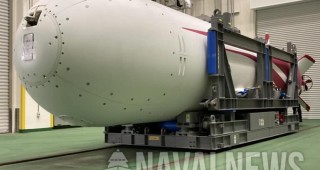Loading
Search
▼ Our First Look at Japan’s New XLUUV Submarine Drone
- Category:Other
Japan’s ATLA (Acquisition, Technology & Logistics Agency) has shown to Naval News its new Extra-large unmanned underwater vehicle (XLUUV). The impressive submarine drone is now in the middle of a research and development (R&D) phase.
In a near-exclusive access (where just Naval News and another Japanese defense outlet were invited), ATLA welcomed us to their IWAKUNI Maritime Environment Test & Evaluation Satellite (IMETS) back in December 2023 to show us their XLUUV. The facility located in Yamaguchi prefecture (Southern Japan) is used to test and develop UUVs.
The new UUV named “Long Endurance UUV” is an experimental XLUUV which was first unveiled during DSEI Japan 2023. The UUV was build by Mitsubishi Heavy Industry (MHI) and it is being developed by the Naval Systems Research Center, one of the sections of ATLA.
As Japan faces an aging society with a declining birthrate, it will become increasingly difficult to operate manned equipment. In particular, it will be difficult to train crews for submarines, and it may become difficult to maintain the number of vessels.
Therefore, Japan is currently accelerating research and development of UUVs as a future complement to underwater defense capability.
The UUV is modular, consisting of a “head section” that carries the control system, an “energy section” that carries the power source, and a “tail section” that carries the propulsion system. This is the basic configuration, and additional payload modules that can carry a variety of equipment can be combined to perform a variety of missions.
As the name “long endurance” implies, this UUV is intended to operate autonomously over a long period of time, and currently in its basic configuration (10 meters in length) has achieved a week of continuous operation at 3 to 4 knots.
However, this is only a milestone, and ATLA is aiming to achieve even longer continuous operation. The UUV is powered by lithium-ion batteries, but ATLA is currently considering the use of liquid/solid fuel batteries, AIP and/or diesel-electric engines in order to achieve a longer cruising range.
Additional payload modules are being researched, including an “underwater equipment installation module” to carry heavy payloads such as sensors/communication nodes, an “ocean observation module” to carry various oceanographic survey equipment, “surface launch module” for launching drones or other equipment at surface, and an “ocean surveillance module” to conduct effective Maritime Domain Awareness(MDA).
Autonomy is the most important aspect of this XLUUV, which aims to operate underwater for long periods of time. Because radio waves cannot be received underwater, it is difficult to control the UUV from a naval vessel or from land.
Autonomous operation is therefore essential. First, the UUV uses a combination of Inertial Navigation System (INS) and Doppler Velocity Log (DVL) as a mechanism to know where it is. In addition, passive sonar is used to detect the vessel’s screw noise and other sounds in order to assess the underwater and above-water situation, and then active sonar is used for a final check when the vessel surfaces.
And as for the control logic, or in other words, the intelligence part, which is the most important for autonomous operation, research is being conducted using huge test facilities.
In Yamaguchi Prefecture, located in western Japan, there is a test facility called the IWAKUNI Maritime Environment Test & Evaluation Satellite (IMETS), which was constructed in 2021. IMETS has a huge water tank, 30 m long, 35 m wide, and 11 m deep.
In this tank, a high-performance simulator and acoustic equipment will reproduce the actual marine environment. UUVs are placed in this tank to simulate the ocean environment, such as currents, water temperature, and salinity, as well as underwater acoustics, and accumulate a variety of data, which can be used to build control logic and development of other senser.
This UUV is only a test bed, which does not mean that it will be operated by the Japan Maritime Self-Defense Force (JMSDF) as is. In fact, using the data obtained from this long-term operational UUV, research is currently underway for a “UUV. control technology”.
This is to develop a UUV that can control by the commanding UUV, and also aims at automatic detection and identification of targets using sonar, etc. The research started in FY2023.
In addition, modules, software etc. have been standardized for this “Long Endurance UUV”, achieving an open architecture. This is intended to enhance UUV technology in both the government and private sector with dual-use technology. So, this UUV also aims to improve UUV technology in Japan as a whole.
- May 6, 2024
- Comment (0)
- Trackback(0)


